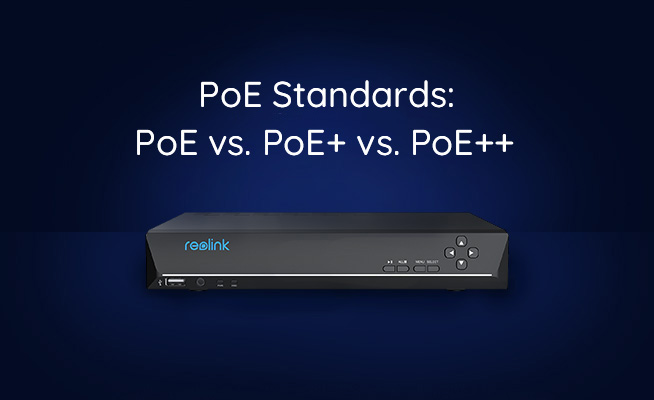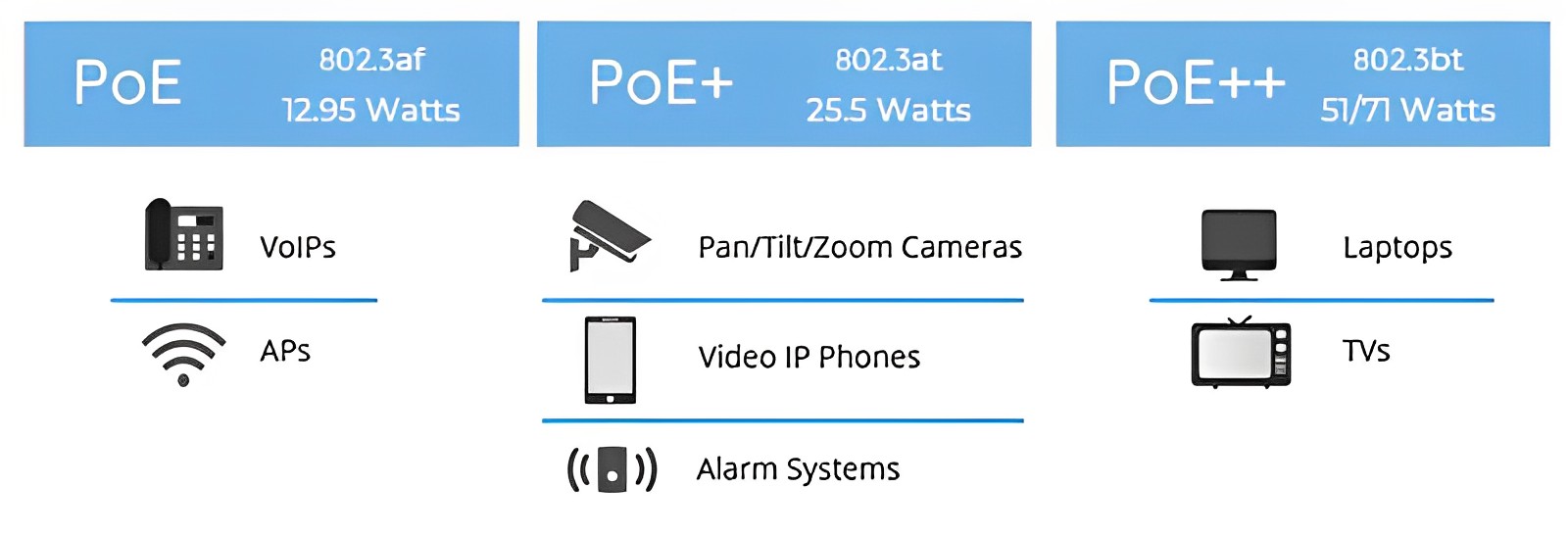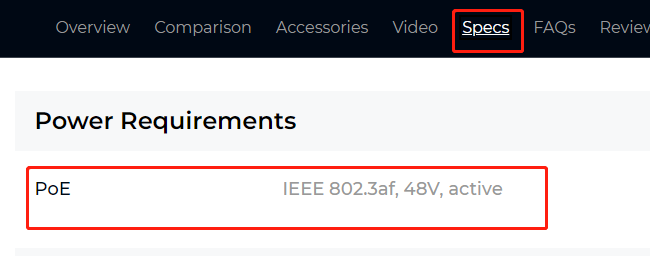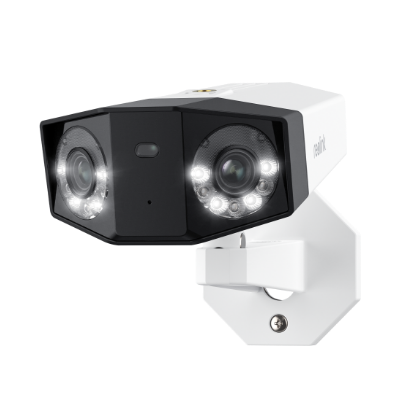PoE vs. PoE+ vs. PoE++ Standards: What is the Difference?

If you’re in the market for a Power over Ethernet (PoE) switch, you might have come across terms like PoE+, PoE++, or even just PoE. But what do these terms mean, and how do you choose the right one for your needs?
In this article, we’ll look at the differences between PoE, PoE+, and PoE++ and compare their typical applications and areas of use. So, whether you’re setting up a home network or outfitting an office, read on to find out which PoE switch is the best fit for you.
- Types of PoE Standards for PoE Switches
- PoE vs. PoE+ vs. PoE++: Basics of Them
- Key Difference between PoE vs PoE+ vs PoE++
- Quick Comparison Chart of the PoE, PoE+, and PoE++
- Which PoE Switch Is the Best For You?
- Reasons to Consider When Upgrading Your PoE Switch
- Additional Factors to Consider When Choosing a Switch
- Bonus Tips: How to Check PoE Standards for Reolink PoE Cameras
- FAQs
- Conclusion
Types of PoE Standards for PoE Switches
Power over Ethernet (PoE) is a technology that enables the transmission of electric current and data simultaneously over Ethernet cables, eliminating the need for separate power cables. This section will provide a brief overview of the three main PoE standards - Type 1, Type 2, and Type 3 - developed by IEEE and explain the key differences between them.
A PoE switch is a network switch that allows data transmission among devices on a network and also supplies power to them via a single cable to the compatible devices. After terminating Ethernet cables and connect it to the switch, users can expand the compatibility of PoE devices. It is often used as a cost-effective option to set up devices like IP cameras, wireless access points, and Voice over Internet Protocol (VoIP) phones in areas without power outlets.
As you may already know, there are different types of PoE (switches). They are generally classified into three based on the IEEE standards:
- Type 1 - PoE
- Type 2 - PoE+
- Type 3 - PoE++
- Type 4 - UPoE
The Institute of Electrical and Electronics Engineers Standards Association (IEEE SA) develops the IEEE standards, which provide rules and benchmarks for producing goods in the electronics and technology industry.
The standard defines two types of devices: power-sourcing equipment (PSE) and powered devices (PDs). PSEs are typically network switches or injectors that supply power over Ethernet cables, while PDs are devices that receive power over Ethernet cables.
Below, we explain the distinct characteristics of the various PoE standards.
PoE vs. PoE+ vs. PoE++: Basics of Them
What is a poe switch?
PoE switches comply with the IEEE 802.3af standard, which specifies the maximum power delivered over Ethernet cables.
The standard specifies that PSEs can supply up to 15.4 watts of power per port, while PDs can consume up to 12.95 watts. PoE switches are commonly used for simple devices like VoIP telephones, stationary cameras, sensors, etc.
Dual-lens security cameras now also use the PoE standard. Reolink, a leading name in surveillance field, ingeniously merges Power over Ethernet technology with a 16MP resolution in their latest model, the Duo 3 PoE. This new release promises a significantly improved monitoring and surveillance experience.
Groundbreaking 16MP Dual-Lens PoE Camera
16MP UHD, Dual-Lens, Motion Track, 180° Wide Viewing Angle, Power over Ethernet, Color Night Vision.
They also have other PoE camera models, such as the affordable Reolink RLC-410, and the smart 4K PoE camera with powerful spotlights, RLC-812A.
What is PoE+ switch?
PoE+ (IEEE 802.3at), also known as PoE plus, is an enhanced version of PoE that provides higher power delivery capabilities. PoE+ switches supply up to 30 watts of power per port, about twice the power supplied by the base PoE standard. The ports have a voltage range of 50-57V.
PoE+ switches can power remote pan, tilt, and zoom (PTZ) surveillance cameras, IP phones, alarm systems, and other devices.
What is PoE++ switch?
PoE++ (IEEE 802.3bt) is the latest version of PoE and has even more remarkable power delivery capabilities than PoE+. PoE++ switches can supply up to 60 watts of power per port, with a voltage range of 52-57V.
The PoE++ has another version often classified as a Type 4; however, it falls under the same IEEE 802.3bt standard.
This variant offers the highest power capabilities of all PoE types. Type 4 PoE switches supply up to 100 watts of power per port with the same voltage range as Type 3.
Switches with PoE++ standards are ideal for gate and building access controls, small computers, TVs, remote patient monitoring devices, etc.
What is UPoE?
UPoE (IEEE 802.3bt) is a variant of PoE++ that provides even higher power delivery capabilities. UPoE devices can supply up to 100 watts of power per port, which is almost seven times the power provided by the original PoE standard. This increased power delivery enables the powering of devices with extremely high power requirements, such as multi-radio access points and building automation systems.

Key Difference between PoE vs PoE+ vs PoE++
As technology advanced, newer PoE standards had to be introduced to keep up with modern devices.
Here are some of the significant differences between the different PoE standards:
- The IEEE standard for the base PoE switches is 802.3af, 802.3at for PoE+, and 802.3bt for PoE++.
- PoE and PoE+ transmit power over two pairs of twisted-pair wires in their cables, while the PoE++ variants use four pairs of twisted-pair wires.
- The maximum power provided per port is different for each switch. PoE delivers up to 15.4 watts of power, PoE+ provides up to 30 watts, and PoE++ provides up to 60 or 100 watts depending on the type.
- Each PoE standard supports different devices. The higher the PoE type, the more powerful and sophisticated devices they can power.
Check the table below for a side-by-side comparison of the different standards.
Quick Comparison Chart of the PoE, PoE+, and PoE++
To give you a quick glance at what the main differences between these three standards are, we've made three tables of comparison.
Table 1. Comparison of Parameters of PoE, PoE+ and PoE++
The comparison dimensions of PoE, PoE+ and PoE++ include IEEE standards, power of switches port, supported cables, etc. This table below has compared main differences between these three PoE standards.
Table 2. Comparison of Operating Conditions of PoE Parameters
Each PoE parameter has its own operating conditions. To work properly, it requires stable power currency, voltage, right power management, modes and comfortable temperatures, as Table 2 shows:
Table 3. Devices Supported By the PoE and PoE+ and PoE++
Different PoE standards match and have their own supported devices. Choosing the right device is the first step to apply for PoE standards. The table below shows you the devices supported by different PoE standards.
Which PoE Switch Is the Best For You?
Based on the amount of power provided, you could say the Type 4 PoE++ is the best. However, choosing the best for YOU is a different matter.
Below are some factors to consider when picking the most suitable PoE switch for your needs:
- Power requirements: The PoE switch must provide enough power for all powered devices (PDs). Compare the total power consumption of your PDs to the PoE switch’s power budget. Your total PD consumption should be less than the power budget.
- Port density: PoE switches offer various numbers of ports, using 8, 12, or 16 ports in smaller networks. Large enterprise and institutional network systems typically require 24, 48, or more ports to manage demand.
- Data rate: Calculate the data rate based on the amount of data and the speed required for upload and transmission. Different PoE switches support standard Ethernet network speeds (10 Base T networks), Fast Ethernet (10 Base T and 100 Base T networks), Gigabit Ethernet (1000 Base T networks), and higher speeds (1/10G). The selected PoE switch must transmit uninterrupted data without power or signal loss.
- Additional products: Determine if other products, such as injectors, converters, or fiber optic cables, are required to support longer-range activity and higher bandwidth.
- Device Compatibility: Not all switches can work with all powered devices. Confirm compatibility between your PDs and the switch you want to buy. For instance, a PoE++ device cannot work with a PoE+ switch.
- Managed vs. Unmanaged switch: Managed switches allow users to adjust the switch’s configuration and provide control over ports, bridges, and network protocols via the management console or a browser-based web interface. On the other hand, unmanaged switches cannot be modified.
Reasons to Consider When Upgrading Your PoE Switch
Upgrading your PoE switch when possible is almost always a good decision. You may find that your current PoE switch setup provides less wattage than your PDs require; that is a good reason to upgrade.
You also don’t lose anything when you upgrade (except money) since PoE standards are backward compatible, meaning a PoE++ switch can support PDs with earlier standards (but a PoE switch cannot power PoE+ and PoE++ devices.
Here are other reasons you may need to upgrade:
Device Compatibility
Perhaps you just got an IP camera(PoE++) unsupported by your PoE+ switch. You will need to upgrade to a PoE++ switch before you can use the camera. The new switch will also likely work with any new devices you plan to buy.
Better Device Performance
Higher PoE standards generally cause better performance in connected devices. For instance, some devices' faster network speeds result in better performance.
Efficient Power Usage
Higher PoE standard switches are better at reducing power loss during transmissions which can help you cut electricity costs.
If your current PoE is sufficient for your needs, you may not need to upgrade. Upgrading to a higher standard switch can be costly, especially if you run a large network.
Additional Factors to Consider When Choosing a Switch
Asides PoE-related capabilities, there are some general factors you should consider when choosing a switch:
- Number and type of ports: When selecting a switch, pick one with enough ports for all the devices you want to connect. Also, consider the type of ports available, as they affect the switch’s speed.
- Network topology: When choosing a switch, you must consider the network topology, such as whether to build a star or ring topology. Different topologies require different types of switches to support them.
- Switch performance: Switch performance includes forwarding rate, cache capacity, processing power, etc. Choosing the switch with the appropriate performance capacity is necessary to handle your network needs, even during busy periods.
- Management: When choosing a switch, you also need to consider management methods, such as WEB interface management, command line management, SNMP management, and so on. You must choose a suitable management method for your technical level and network management needs.
- Reliability: The switch is the network's core equipment and must ensure reliability. Look for ones with redundancy features that keep the switch safe from complete breakdowns.
- Security: Ensure that the switch has security features such as Virtual LANs (VLANs) support, MAC address filtering, access control lists (ACLs), and more to protect the network from threats.
Bonus Tips: How to Check PoE Standards for Reolink PoE Cameras
Once you understand the differences between PoE, PoE+, and PoE++, you might wonder how to check the PoE standards of various devices, such as Reolink PoE cameras. Here are some simple ways to find out:
- Visit the product page: Navigate to the “Specs” section and look under “Power Requirements” to get the full PoE information for our cameras. For example, here is the PoE standard for the Duo 3 PoE.

- Download the product specification sheet: This can also be found on the product page under the "Specs" section.
- Contact support team: If you have any more questions about the PoE requirements for your cameras, feel free to reach out to our support team for assistance!
FAQs
Is PoE++ backwards compatible with PoE+?
Yes, PoE++ is backward compatible with PoE+ and PoE. It automatically adjusts power based on the device’s needs, so lower-powered devices stay safe while maintaining full compatibility.
Do I need PoE+ or PoE++?
PoE standards supply power and data through Ethernet cables to devices such as cameras and phones. PoE+ delivers higher power than standard PoE, and PoE++ offers the greatest output for more demanding devices.
Can I plug a PoE+ device into a PoE++ port?
Yes, you can plug a PoE+ device into a PoE++ port. The PoE++ port will detect the device’s power needs and only supply the right amount. It is safe and fully compatible.
How many watts is PoE or PoE+ or PoE ++?
PoE++ (802.3bt) provides up to 60 watts of power to each port in Type 3 and up to 100W on each PoE port in Type 4. This is significantly higher than the power provided by PoE (802.3af) and PoE+ (802.3at), which provide up to 15.4 watts and 30 watts of power, respectively. The higher power levels of PoE++ allows it to power high-performance devices such as building management devices and small computers.
How far can PoE ++ carry power?
PoE++ can carry power up to a distance of 100 meters (328 feet) over standard Ethernet cables, such as Cat5e, Cat6, or higher. This distance is defined by the IEEE 802.3bt standard and applies to both Type 3 (60W) and Type 4 (90W) PoE++ power levels.
Can cat 6 handle PoE++?
Yes, Cat6 cables support PoE++ (up to 100W), depending on cable quality and installation conditions. For higher power loads, using shielded Cat6 is recommended.
Conclusion
Wrapping up, we’ve learned the various standards for PoE switches, and a significant difference is the amount of power each standard provides.
Understanding the differences among the poe vs poe+ vs poe++ standards can help you make an informed decision when choosing the best option for your needs. Remember, you don’t need to upgrade to a higher standard if your current PoE switch is sufficient and you don’t plan on adding new devices to your network.
Search
Subscribe for the Latest Updates
Security insights & offers right into your inbox

